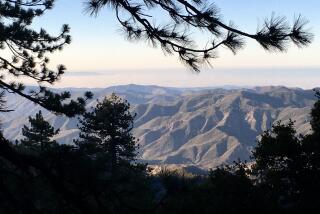A Speedy Rebuke for ‘Terminal Velocity’ : Movies: The Bureau of Land Management cites the film’s producers for airdropping a car into an Inyo Mountains wilderness area.
- Share via
Environmentalists asked the filmmakers to go shoot elsewhere. But the movie company believed the mountainous setting was a perfect location. The Bureau of Land Management agreed under certain conditions, and issued the filmmakers a permit. Now, none of the parties appears satisfied.
On Tuesday, BLM officials slapped a citation on Interscope Communications, producers of “Terminal Velocity,” for dropping a Cadillac by helicopter into a proposed protected wilderness area that the movie crew was asked to avoid in the Inyo Mountains in southeastern California. The stunt-filled action movie stars Charlie Sheen.
BLM spokesman Lee Delaney said the independent production company making the feature was able to execute an earlier car drop successfully in a less environmentally sensitive area of the Saline Valley, where it had been issued a permit. But, Delaney said, Interscope failed to keep within restricted boundaries for the subsequent drop in a wilderness study area.
Such a mishap was feared by the environmental group Desert Survivors, which unsuccessfully sought to prevent the producers access to the Saline Valley by appealing to the BLM prior to filming.
Delaney said the citation lists three violations and seeks a hearing before a magistrate in Bishop to determine if a fine should be imposed against Interscope. A spokeswoman for the company, headed by Ted Field and Robert Cort, offered no comment until the document is in house.
“There was virtually no damage . . . no impairment to the wilderness area,” Delaney said. “They came back in with rakes and brooms to restore the slope . . . but they weren’t supposed to go there in the first place.”
*
Delaney said location supervisors on “Terminal Velocity” told him the film’s helicopter pilot was forced off course by strong winds on the second day of its two-day shoot. The company had put up a $50,000 bond, which it said in a statement answering the environmentalists’ appeal “is now not recoverable.”
The 1,000-member Desert Survivors organization said it had no objection to the moviemakers shooting in the other desert locations of the Panamint Valley and Cuddeback Lake, but not in the Inyo Mountains, home to ancient bristlecone pines, bighorn sheep and the endangered Inyo Mountain salamander. The area where the violation occurred is within the boundaries of Inyo Mountains Wilderness proposed for future protection under the California Desert Protection Act (S. 21) now before Congress.
“Although the physical damage on the ground might not be severe, the fact it was approved . . . is a slap in the face for those of us who’ve worked for years to keep these lands pristine,” said Douglas Kari, the attorney who represents Desert Survivors.
This is not the first time environmentalists have clashed with moviemakers. Three years ago, state park rangers and environmentalists were appalled to learn that phony Indian pictographs drawn for Oliver Stone’s movie “The Doors” couldn’t completely be removed from the walls of a limestone cave at Mitchell Caverns Natural Preserve in the Mojave Desert.
And this fall an Oregon environmental group sought to prevent the producers of “The River Wild,” starring Meryl Streep, from filming on a wilderness stretch of the Rogue River, contending that the influx of crew and movie equipment would cause irreparable harm to the area. When the producers scaled back its crew to fewer than 20, the Oregon Natural Resources Council gave its blessings to shooting on the river.
More to Read
The biggest entertainment stories
Get our big stories about Hollywood, film, television, music, arts, culture and more right in your inbox as soon as they publish.
You may occasionally receive promotional content from the Los Angeles Times.










